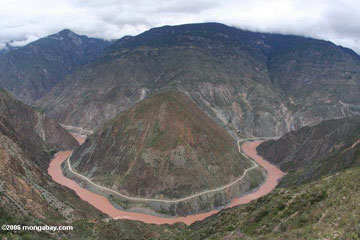Will earthquake slow dam-building spree in China?
Will earthquake slow enthusiasm for dam-building in China?
mongabay.com
May 14, 2008
Monday’s 7.9 magnitude earthquake in Sichuan province left more than 15,000 dead, 26,000 missing, and 64,000 injured, according to state media. The quake also “seriously damaged” two hydroelectric stations in Maoxian county, leading authorities to warn that the dams could burst. More than 2,000 troops were sent to work on the Zipingku Dam, a dam said to be in “great danger” of collapse upriver from Dujiangyan, a city near the quake’s epicenter. Overall, China’s economic planning agency says that 391 dams in the region have been affected by the quake.
With China’s hydroelectric projects already facing criticism for their social and environmental impact, the damage to China’s dams from the earthquake renews the question of whether China’s dam-building spree is the best path to meet surging energy demand in the country. China has ambitious plans to expand hydropower capacity, including more than a dozen power plants on the upper reaches of the Yangtze and Mekong rivers, but there are signs that the government may be having second thoughts at some sites.

The muddy upper Yangtze in northwestern Yunnan. Dams have displaced millions of Chinese in recent years.
|
In December China abandoned plans to build dams at Tiger Leaping Gorge, a popular tourist area in Yunnan Province, and Mugecuo Lake, a site in Sichuan Province. The government has also moved to re-evaluate other projects, including dams on the Nu River and at Yuanmingyuan Lake. More recently, officials have expressed concern over the impact of Three Gorges Dam —the world’s largest hydropower project — which has been blamed for a host of problems ranging from water shortages to worsening pollution to catastrophic landslides. Some experts have warned that $22 billion dam could worsen the very floods it was build to control.
Aging dams
In government study released in January, China said that 37,000 of the country’s 87,000 dams were “dangerously unstable” and in urgent need of repair. The country said it would spend more than $1.3 billion per year fixing vulnerable dams, many of which were poorly constructed in the 1950s, 1960s, and 1970s.
Hydropower currently accounts for 6 percent of China’s energy generation. Under a plan to boost the share of renewable energy produced in the country to 15 percent of total energy output, the government aims to triple hydroelectric capacity to 300 gigawatts by 2020.
** Update **
International Rivers, a U.S. environmental group, notes that China is building “scores of large dams in the country’s southwest.” It calls the plan “a risky proposition in an earthquake-prone area.”















